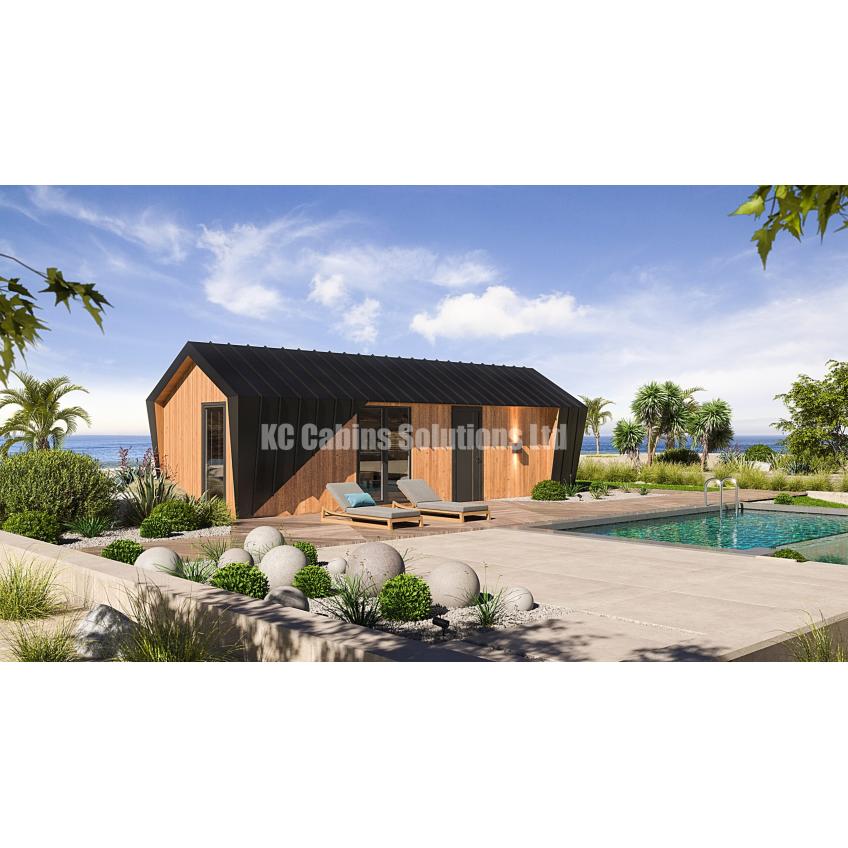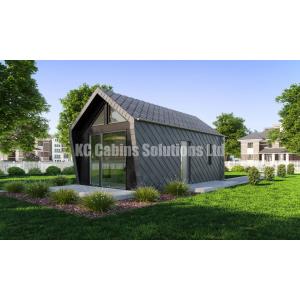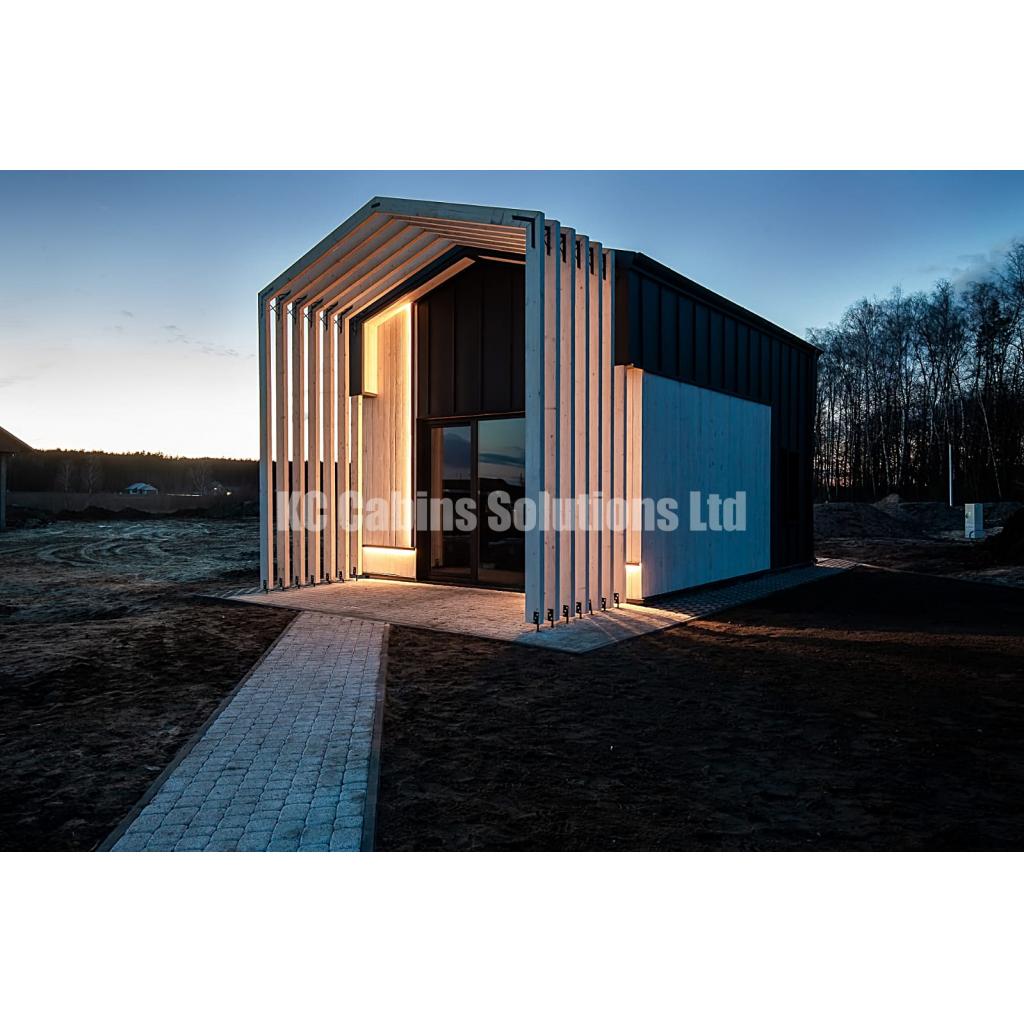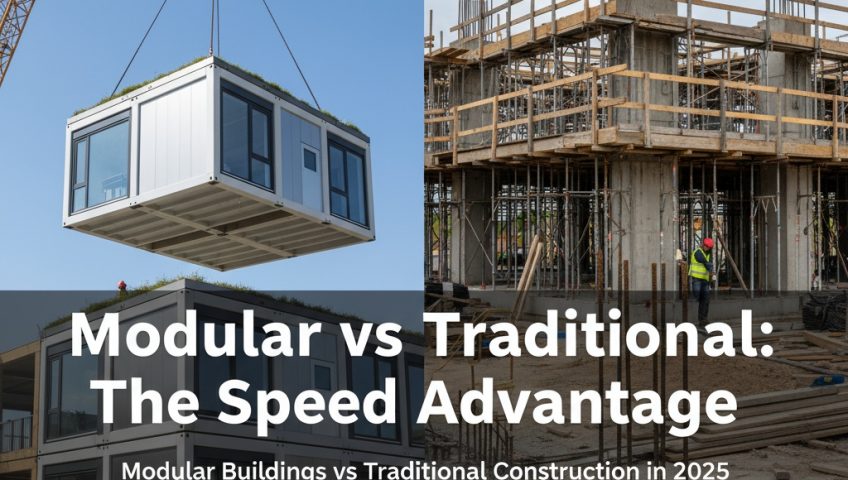
Modular vs Traditional Construction: 2025 Cost Analysis
Modular vs Traditional Construction: Cost Comparison & ROI Analysis

The modular vs traditional construction debate is heating up in 2025. As UK businesses face rising costs, labour shortages, and tight timelines, modular buildings offer a compelling alternative. But how much cheaper is modular construction really? And is it as durable as traditional builds?
This comprehensive guide compares modular and traditional construction costs, timelines, and quality standards using real 2025 data. You'll discover how modular buildings can save 7–36% on project costs while cutting construction time by 12–35 weeks.
The Cost Myth: Why Modular Seems Expensive (But Isn't)
Many UK businesses assume modular buildings cost more than traditional construction. This misconception stems from higher upfront factory costs and premium manufacturing standards.
However, when you factor in the total cost of ownership—including labour, materials, weather delays, change orders, and financing—modular buildings typically cost 7–36% less than traditional construction.
Real Numbers: Modular vs Traditional Construction (2025)
Let's break down the actual costs for a typical commercial project:
| Cost Category | Modular Building | Traditional Construction | Saving |
|---|---|---|---|
| Design & Approval | £8,000 | £12,000 | £4,000 |
| Manufacturing/Build | £85,000 | £95,000 | £10,000 |
| Labour Costs | £18,000 | £35,000 | £17,000 |
| Materials & Waste | £12,000 | £28,000 | £16,000 |
| Weather Delays & Overruns | £0 | £18,000 | £18,000 |
| Change Orders & Rework | £3,750 (3%) | £11,250 (9%) | £7,500 |
| Total Project Cost | £126,750 | £199,250 | £72,500 (36%) |
Source: KC Modular Buildings real project data, 2025. Costs vary by location, size, and complexity.
Where Modular Wins on Cost (5 Key Areas)
1. Labour Efficiency Savings
Modular buildings are 90% factory-completed, dramatically reducing on-site labour. Factory workers are more productive than site teams, and there's no weather downtime. This cuts labour costs by 40–50% compared to traditional construction.
2. Material Waste Reduction
Traditional construction generates 30–50% material waste. Modular manufacturing uses precision cutting and recycling systems, reducing waste to just 5–10%. This saves money and aligns with sustainability goals.
3. No Weather Delays
UK weather is unpredictable. Rain, snow, and frost can halt traditional construction for weeks. Modular buildings are manufactured indoors, eliminating weather delays and keeping projects on schedule.
4. Predictable Pricing & No Change Orders
Modular projects have fixed pricing agreed upfront. Traditional construction often sees 8–15% cost overruns due to design changes, site conditions, and unforeseen issues. Modular eliminates this uncertainty.
5. Faster Occupancy = Faster ROI
Modular buildings are ready 12–35 weeks faster. For commercial projects, this means faster revenue generation, lower financing costs, and quicker return on investment.
Timeline Comparison: Modular vs Traditional Construction
The speed advantage of modular construction becomes crystal clear when you compare week-by-week progress. Here's how the two approaches diverge:
Weeks 1–3: Design & Approval

Modular design is fast-tracked and standardised. Traditional design requires lengthy consultations, planning permission applications, and structural engineering reviews.
Weeks 4–11: Manufacturing
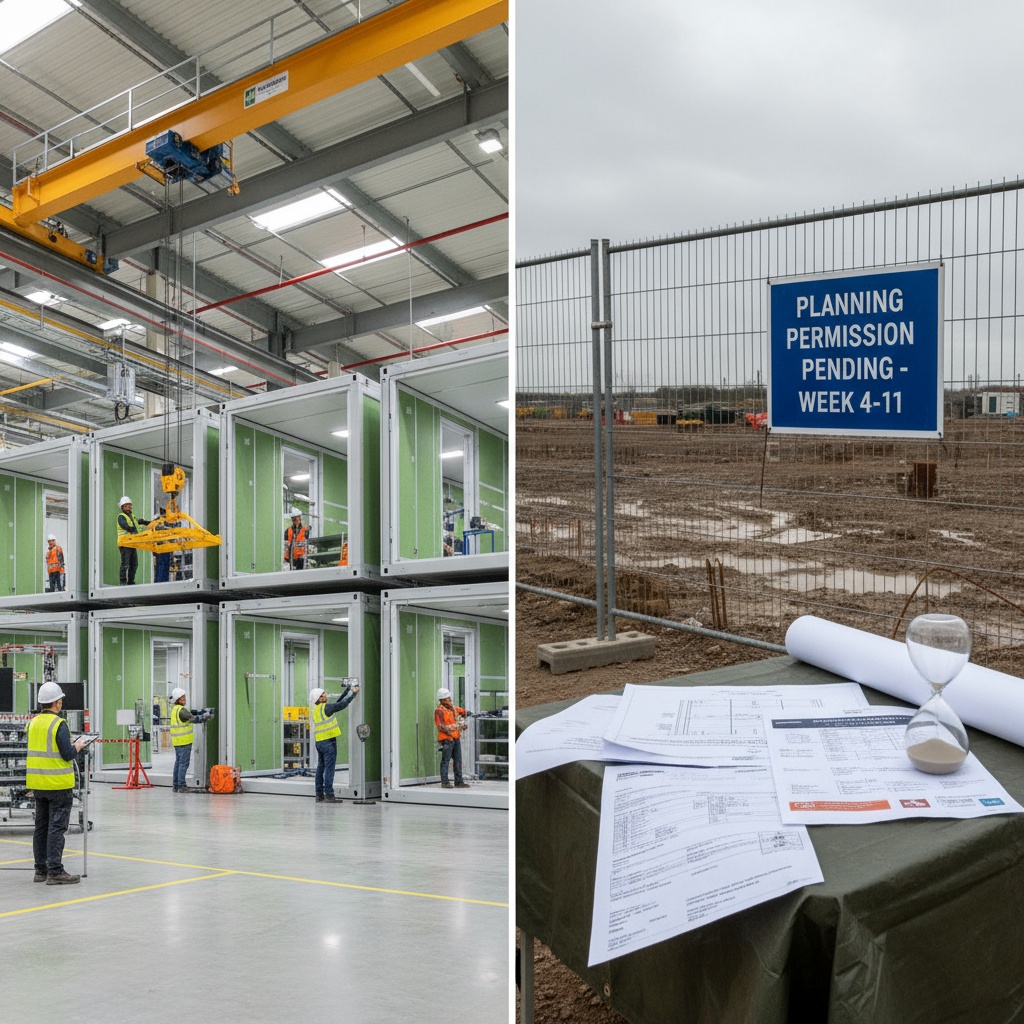
Modular units are manufactured in parallel in our UK factory. Traditional construction is still waiting for planning permission and site preparation.
Weeks 5–16: Planning Permission
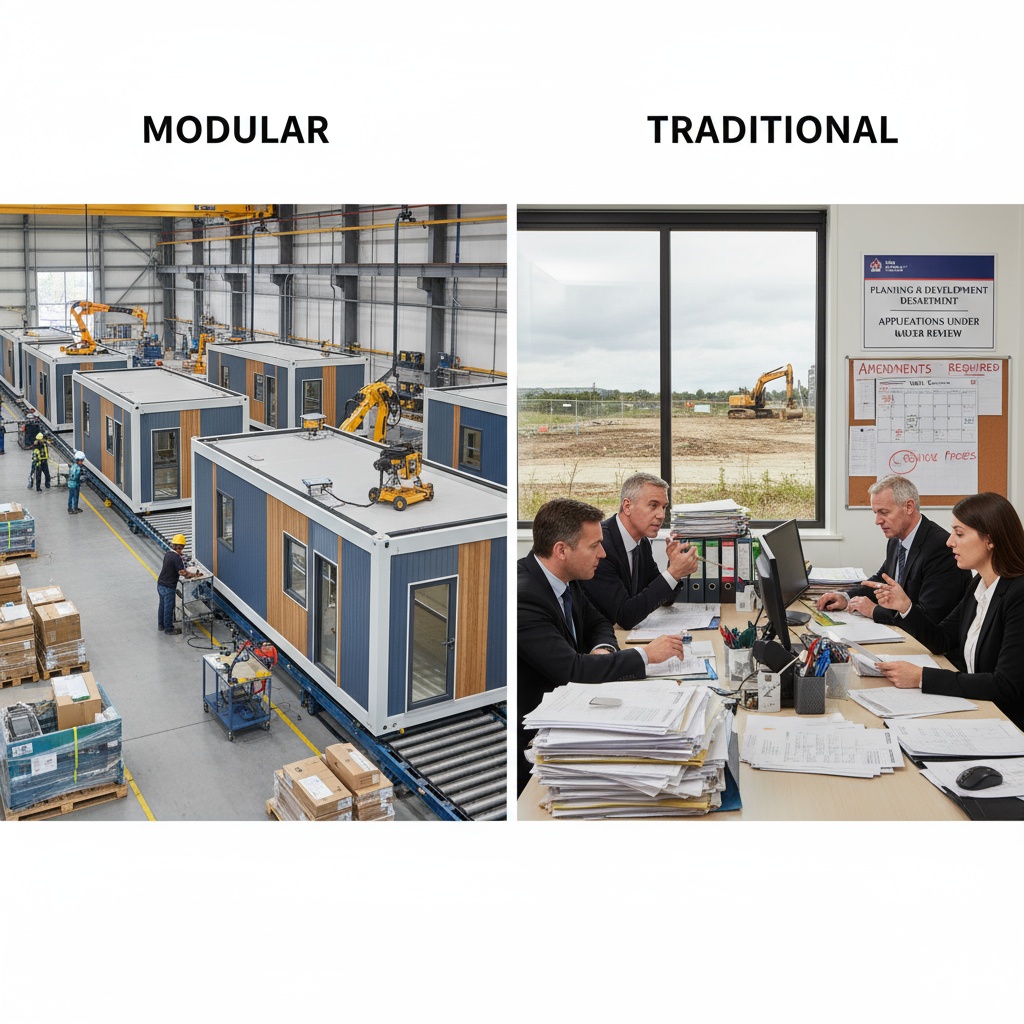
Modular manufacturing continues while traditional projects face bureaucratic delays. Many modular buildings qualify for permitted development, skipping planning entirely.
Weeks 12–13: Delivery & Installation
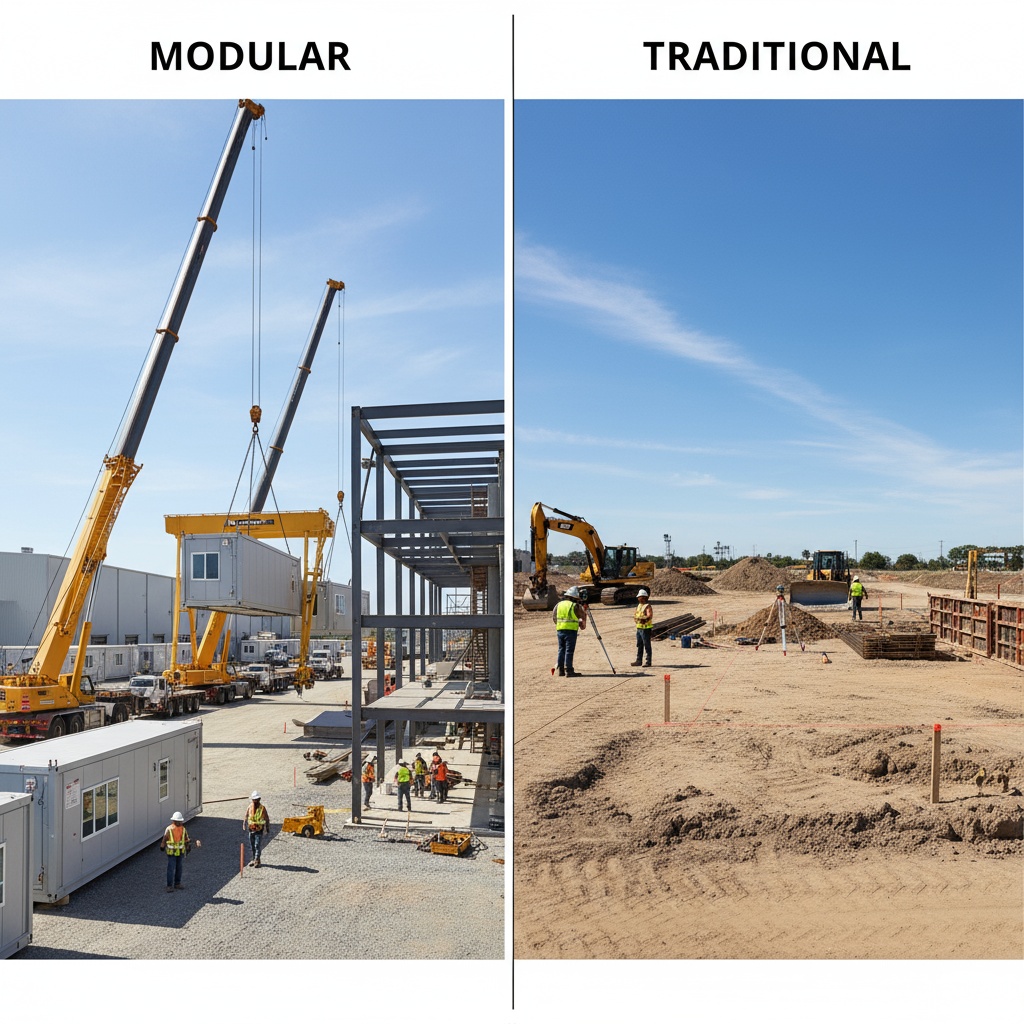
Modular units are delivered and installed. Traditional construction is just beginning site preparation and foundation work.
Weeks 14–17: Handover

Modular buildings are nearly complete and ready for handover. Traditional construction is mid-foundation stage.
Weeks 17–20: Site Prep & Foundations

Modular buildings are operational and generating revenue. Traditional construction is still excavating and pouring foundations.
Weeks 21–36: Construction Phase
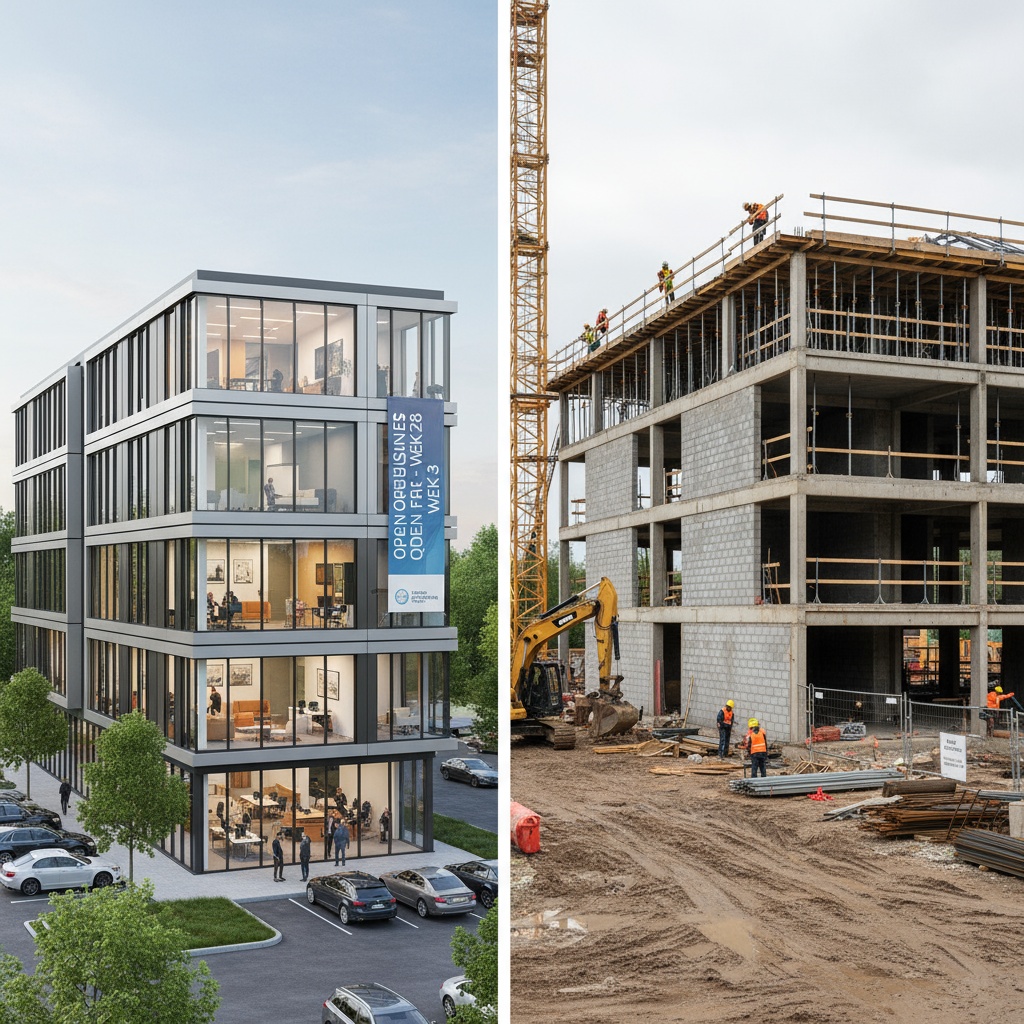
Modular buildings are fully operational. Traditional construction is in the structural frame-up phase—15+ weeks behind.
Weeks 37–42: Trades & Systems
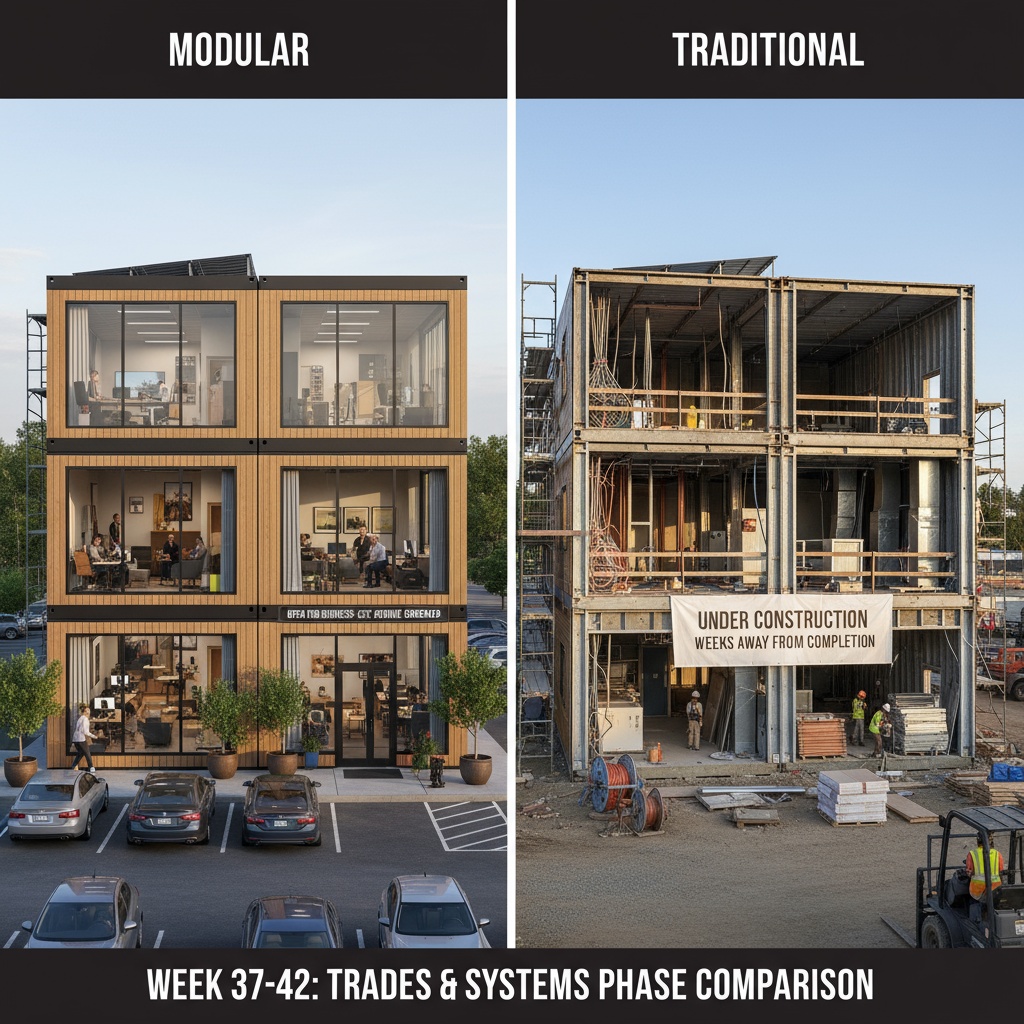
Modular buildings are months ahead. Traditional construction is installing MEP (mechanical, electrical, plumbing) systems.
Weeks 43–46: Finishing & Snagging
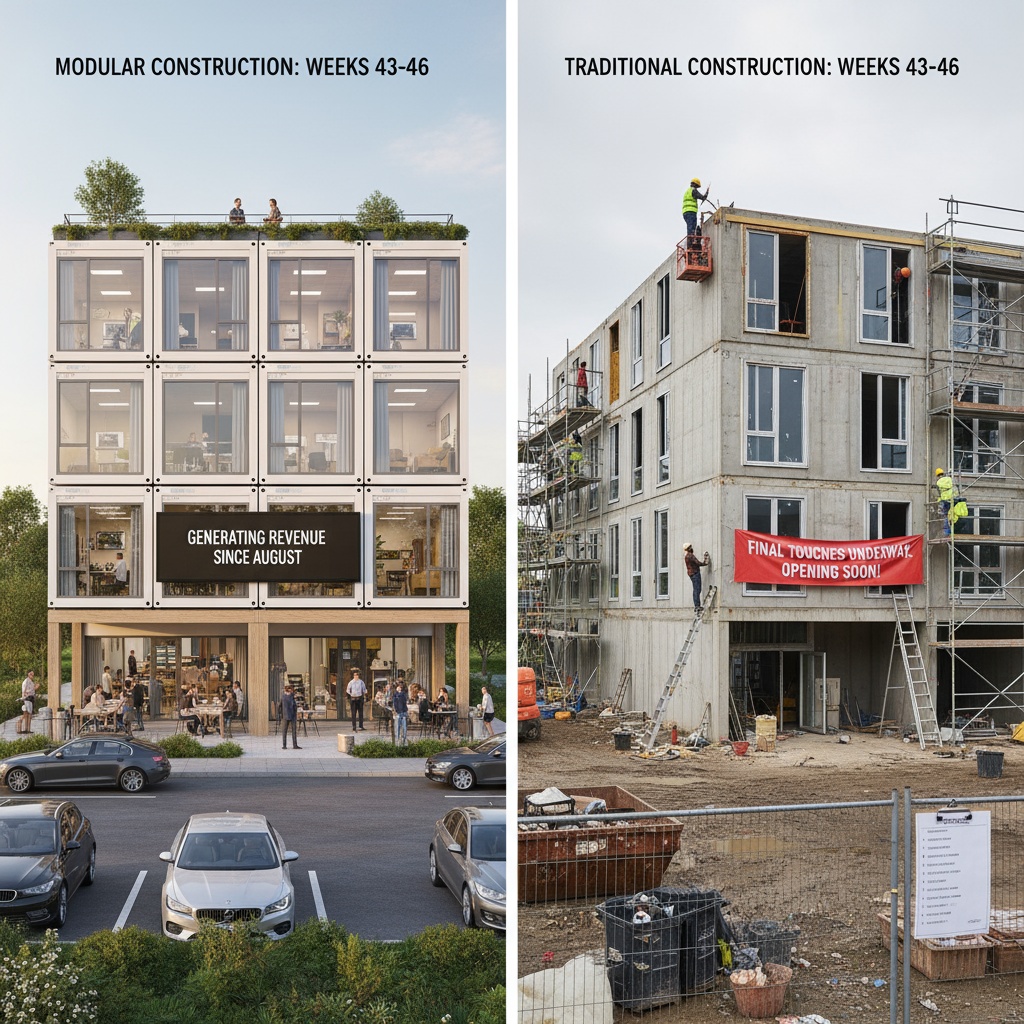
Modular buildings are months ahead of schedule. Traditional construction is in final finishing stages.
Weeks 47–52+: Delays & Overruns
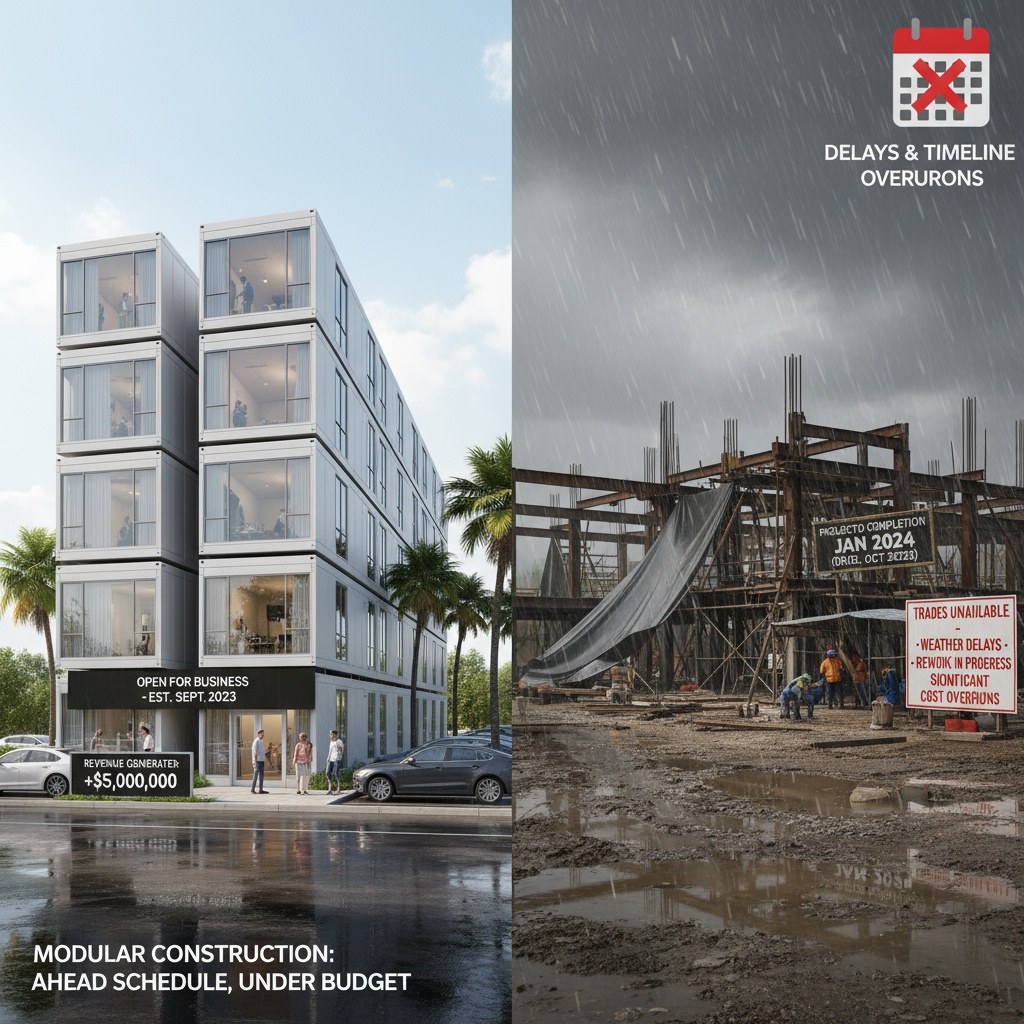
Modular projects are complete and proven. Traditional construction faces weather delays, labour shortages, and potential overruns.
Final Comparison: The Speed Advantage
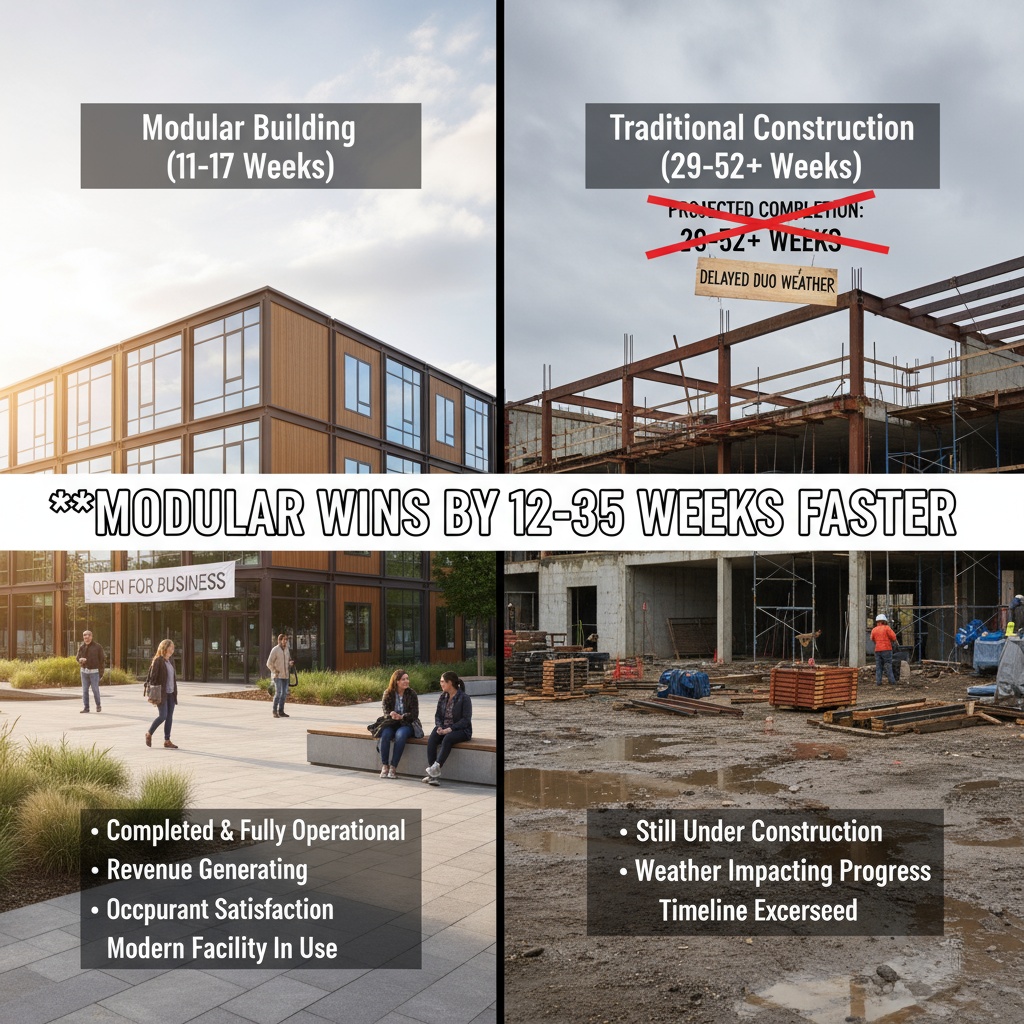
The stark contrast is clear: modular construction delivers 12–35 weeks faster than traditional methods. This timeline advantage translates directly into cost savings, faster revenue generation, and reduced financing costs.
When Traditional Construction Costs Less
While modular wins in most scenarios, traditional construction can be more cost-effective in specific situations:
- Highly customised buildings with bespoke architectural designs
- Very large projects (10,000+ m²) where site labour becomes cheaper
- Existing site infrastructure that can be leveraged
- Projects with unlimited budgets where speed isn't a priority
For most UK businesses—especially those needing fast, predictable, energy-efficient buildings—modular construction delivers superior value.
Hidden Costs of Traditional Construction
Traditional construction often hides costs that aren't immediately obvious:
- Weather delays (£2,000–£5,000/week)
- Labour shortages & wage inflation
- Design changes (8–15% cost overruns)
- Material price fluctuations
- Site contamination & unforeseen issues
- Extended financing costs
- Defect rectification (snagging)
- Fixed pricing agreed upfront
- No weather delays
- Predictable timelines
- Quality guaranteed by ISO standards
- Factory-controlled manufacturing
- Minimal financing period
- 15-year structural warranty
Traditional projects typically experience £24,000–£78,000 in hidden costs (17–39% of budget). Modular eliminates most of these.
Quality Comparison: Modular vs Traditional
Does modular construction compromise on quality? Absolutely not. In fact, modular buildings often exceed traditional construction standards:
| Quality Metric | Modular Buildings | Traditional Construction |
|---|---|---|
| Structural Lifespan | 50–75 years | 50–100 years |
| Warranty Period | 15 years structural + 2 years defects | 10 years NHBC (varies) |
| Energy Efficiency | A-rated, U-value 0.11–0.18 W/m²K | B–D rated, U-value 0.20–0.35 W/m²K |
| Air Permeability | 1.57 m³/(h.m²) (excellent) | 5–8 m³/(h.m²) (typical) |
| Quality Control | ISO 9001, 1090, 3834 certified | Variable (site-dependent) |
| Defect Rate | <2% (factory precision) | 5–10% (site variability) |
| Fire Safety | EN 13501-1 B-s2, d0 compliant | Building Regulations compliant |
Modular buildings are manufactured in controlled factory environments with ISO certification, resulting in superior quality and fewer defects than site-built construction.
Total Cost of Ownership (TCO) Analysis
Looking beyond initial build costs, modular buildings offer superior long-term value:
Modular: £126,750 (build) + £15,000 (maintenance) + £8,000 (financing) = £149,750
Traditional: £199,250 (build) + £28,000 (maintenance) + £18,000 (financing) = £245,250
10-Year Saving: £95,500 (39%)
Modular buildings also generate faster ROI due to earlier occupancy. A commercial modular office can start generating revenue 12–35 weeks earlier, translating to additional income of £40,000–£150,000+ depending on rental rates.
When to Choose Modular vs Traditional
Choose Modular If You Need:
- ✅ Fast delivery (weeks, not months)
- ✅ Predictable costs and fixed pricing
- ✅ Energy-efficient, modern buildings
- ✅ Minimal on-site disruption
- ✅ Quality assurance and ISO certification
- ✅ Flexibility to relocate or expand
- ✅ Lower total cost of ownership
- ✅ Sustainable, low-waste construction
Choose Traditional If You Need:
- ❌ Highly bespoke, one-off architectural designs
- ❌ Very large projects (10,000+ m²)
- ❌ Complex site conditions requiring custom solutions
- ❌ Unlimited budget with no timeline pressure
Industry-Specific Cost Comparisons
Modular Offices vs Traditional Offices
For commercial offices, modular wins decisively. A 50ft × 28ft modular office (1,400 m²) costs £126,750 vs £199,250 traditional—a 36% saving. Plus, modular offices are ready 17 weeks faster, allowing businesses to occupy and generate revenue sooner.
Modular Classrooms vs Traditional Schools
Educational institutions benefit hugely from modular classrooms. A modular classroom block (500 m²) costs £45,000–£65,000 vs £75,000–£95,000 traditional. Schools can expand capacity without lengthy construction disrupting students. Plus, modular buildings meet all DfE (Department for Education) standards and accessibility requirements.
Modular Healthcare vs Traditional Clinics
Healthcare facilities need rapid deployment. Modular medical clinics cost 20–30% less than traditional builds and are ready in 12–16 weeks. They feature hygienic GEBERIT sanitary systems, soundproofing, and medical-grade finishes—perfect for NHS contractors and private clinics.
Modular Welfare Units vs Traditional Site Facilities
Construction contractors rely on welfare units. Modular welfare units (6m × 3m) cost £18,000–£24,000 vs £28,000–£35,000 traditional. They're DfE-compliant, stackable up to 3 storeys, and ready to deploy immediately on-site.
Real Project Example: Pendell Camp Utility Blocks
Here's a real-world case study demonstrating modular advantages:
Project: Pendell Camp Utility Blocks (Surrey County Council)
Requirement: 4 modular utility blocks, 7.25m × 3.45m each, with sedum roofs, triple-glazed UPVC windows, and accessibility compliance (Part M, Category 2)
Modular Solution:
- Design & approval: 3 weeks
- Manufacturing: 8 weeks
- Delivery & installation: 2 weeks
- Total timeline: 13 weeks
- Cost: £89,000 (4 units)
Traditional Alternative (estimated):
- Design & planning: 8 weeks
- Planning permission: 8–12 weeks
- Construction: 16 weeks
- Total timeline: 32–36 weeks
- Estimated cost: £145,000–£165,000
Modular Advantage: 19–23 weeks faster, £56,000–£76,000 cheaper
Frequently Asked Questions
Modular buildings typically cost 7–36% less than traditional construction when accounting for faster delivery, eliminated change orders, and lower maintenance. A 50ft × 28ft office costs £126,750 modular vs £138,000–£199,800 traditional.
Total timeline is 11–17 weeks (design, manufacturing, delivery, installation). Traditional construction takes 29–46 weeks or longer, depending on planning permission and site conditions.
Yes. Modular buildings have a 50–75 year structural lifespan with 15-year warranties. ISO 9001, 1090, and 3834 certification ensures consistent quality and superior defect control compared to site-built construction.
Site conditions, design changes, labour shortages, weather delays, rework, and financing costs typically add £24,000–£78,000 (17–39% of budget). Modular construction eliminates most of these through fixed pricing and factory control.
Yes, but extensive customisation can increase costs and timelines. Standard modular designs offer best value; bespoke designs work better with traditional construction. KC Modular Buildings offers flexible layouts (6×3m to 12×6m) and customisation options.
Yes. Modular buildings are A-rated with U-values of 0.11–0.18 W/m²K, triple-glazed windows, and air permeability of 1.57 m³/(h.m²). They exceed Part L 2021 Building Regulations and feature SCOP 4.5 air-to-air heat pump systems.
KC Modular Buildings holds ISO 9001 (Quality), ISO 1090 & 3834 (Steel & Welding), ISO 14001 (Environmental), ISO 27001 (Information Security), and is UKAS accredited as a Type C inspection body. All buildings meet Building Regulations, fire safety, and accessibility standards.
Yes. Modular buildings are designed for flexibility. Units can be relocated, reconfigured, or expanded to accommodate changing business needs. This makes them ideal for growing companies and temporary facilities.
Final Verdict: Modular vs Traditional Construction
For most UK businesses in 2025, modular construction is the clear winner.
Here's why:
- Cost: 7–36% cheaper when accounting for total cost of ownership
- Speed: 12–35 weeks faster delivery
- Quality: ISO-certified manufacturing with superior defect control
- Predictability: Fixed pricing, no change orders, no weather delays
- Sustainability: 90% less waste, A-rated energy efficiency
- Flexibility: Relocatable, expandable, customisable
- ROI: Faster occupancy = faster revenue generation
Whether you're a commercial developer, construction contractor, educational institution, or healthcare provider, modular buildings deliver superior value, speed, and quality compared to traditional construction.
The question isn't whether modular construction is good enough—it's whether you can afford to wait for traditional construction.
Ready to Explore Modular Solutions?
Get a free cost comparison and timeline estimate for your project. Our experts will show you exactly how much you can save with modular construction.
Get Your Free Quote TodayNo obligation. Takes 2 minutes. Speak to a modular expert.
Published: 8 November 2025
Updated: 8 November 2025
Author: KC Modular Buildings
Category: Modular Construction, Cost Comparison, Building Solutions
All costs and timelines are based on 2025 market data and real KC Modular Buildings projects. Prices vary by location, size, and complexity. Contact our team for a personalised quote.
Industry Standards & Resources
Our modular buildings comply with the latest UK construction standards and regulations. Here are the key industry resources and certifications that ensure quality and compliance:
Building Regulations & Standards
- UK Building Regulations Approved Documents – Official government guidance on Part L 2021 energy efficiency standards
- ISO 9001 Quality Management – International standard for quality assurance in manufacturing
- ISO 14001 Environmental Management – Environmental sustainability certification for construction
- KINGSPAN QuadCore Technology – Premium insulation panels used in our modular buildings
Construction Industry Insights
- RICS Construction Standards – Royal Institution of Chartered Surveyors guidance on construction costs
- CIOB Construction Research – Chartered Institute of Building industry reports and analysis
- Build Offsite – UK's leading authority on modern methods of construction and modular building
Energy Efficiency & Sustainability
- BRE Air Tightness Standards – Building Research Establishment air permeability testing guidance
- WRAP Construction Waste Reduction – Waste and Resources Action Programme for sustainable construction
- GEBERIT Sanitary Systems – Premium sanitary systems with 25-year warranties used in our buildings
All KC Modular Buildings are manufactured to exceed these industry standards, ensuring quality, durability, and compliance with UK regulations.

